![]() The Pacific War Online Encyclopedia
The Pacific War Online Encyclopedia
|
| Previous: Kamikaze Class, Japanese Destroyers | Table of Contents | Next: Kamloops |
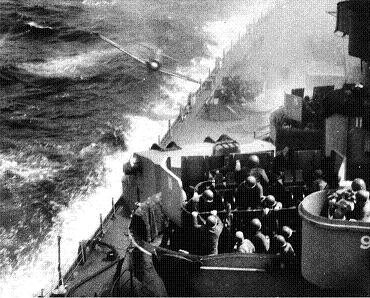
Naval
Historical Center #NH 62696
Fleet Admiral Chester Nimitz
once said that the only aspect of the Pacific War that was entirely
unanticipated
in prewar planning was the kamikazes. These were Japanese
pilots who deliberately
crashed their bomb-laden
aircraft onto Allied ships
during the desperate final year of the war. Kamikazes caused more
Allied naval
casualties during the war than
any other Japanese weapon.
The Japanese officially referred to the kamikazes as Special Attack Units (tokubetsu kōgeki tai, usually contracted to tokkō. The attacks were informally described using the characters 神風, "divine wind", which alludes to a typhoon that destroyed an invading Mongol fleet in medieval times. These characters can be read either as shinpu or kamikaze; the latter reading was widely applied to suicide attackers by Allied intelligence officers, but the Japanese themselves preferred shinpu.
The act of deliberately crashing a crippled aircraft into an enemy position long preceded the kamikaze campaign and may not have been a uniquely Japanese action. One of the first American heroes of the Pacific War was Colin Kelly, a B-17 pilot who remained at the controls of his crippled bomber long enough for the rest of his crew to escape. The bomber exploded before Kelly could himself get clear, and for this genuine act of heroism Kelly was posthumously awarded the Distinguished Service Cross. However, the tale grew in the telling, and eventually the story circulated that Kelly had deliberately crashed his crippled bomber into a Japanese battleship. Likewise, the (most likely unintentional) crash of a Marine pilot into a Japanese cruiser at Midway was held up as an example of self-sacrifice. A number of Japanese pilots dove their crippled aircraft into American ships during the series of carrier battles off Guadalcanal, and at least some of these were deliberate acts. Indeed, they became common enough that the Japanese began referring to them as jibaku (自爆, "suicide bombing"). Jibaku were distinct from true kamikaze missions in that the pilot did not set out with the intent to carry out a suicide attack, but made a snap decision to to so after his aircraft was crippled while attempting a conventional attack.
The idea of deliberately sending pilots out to crash into American ships may have originated with Kuroshima Kameto, the brilliant but highly eccentric staff officer who did much of the planning for the Pearl Harbor attack. When Kuroshima was appointed as chief of operations (N2) for the Navy General Staff in August 1943, he began arguing to his superiors that suicide tactics would be necessary to change the course of the war. However, the first organized kamikaze attack was not launched until 5 July 1944 from Iwo Jima. This attack was ordered by the local commander in response to a devastating carrier strike the previous day. The 17 planes involved in the attack were intercepted 60 miles from the American fleet and suffered heavy losses. The five survivors took cover in bad weather and eventually made it back to base without ever sighting any American ships. Four of the aircraft were destroyed on the ground the next day by naval bombardment.
The first successful kamikaze attacks took place during the Battle of Leyte Gulf, on 25 October 1944, just after the action off Samar. These attacks were ordered by Onishi Takijiro, who was initially opposed to suicide tactics. However, Onishi had been approached by Jo Eiichiro, the Emperor's naval aide-de-camp, who argued for suicide attacks. On taking up command of 1 Air Fleet in the Philippines
and discovering how meager his resources were, Onishi concluded that no
other tactics would allow the land-based aircraft under his command to
give meaningful support to the Sho operation. The attacks succeeded in sinking the escort carrier St.
Lo
and badly damaging three others. Though the attacks seem to have been
originally viewed as a temporary expedient in support of a critical
battle, thereafter the kamikaze attack became a regular feature of the naval war in the western Pacific. The kamikaze campaign reached its climax during the battle of Okinawa in March-May 1945.
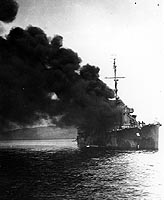
National Archives #80-G-270773
The kamikazes were a desperate response to the increasingly effective antiaircraft and fighter defenses of U.S. task forces. Since attacks on American ships had already become suicidal, some Japanese commanders took the logical step of making suicide a deliberate part of the attack pattern. A suicide pilot could be trained relatively quickly, since he only needed enough training to get off the ground, follow a lead plane to the target area, and point his aircraft at a ship. Furthermore, because of the nature of the attack, the plane had to be completely destroyed, not just damaged, if it was to be stopped. The kamikazes also made optimum use of Japan's remaining resources. Japanese aircraft factories were still untouched by strategic bombing, making it easier for the Japanese to manufacture aircraft than to train pilots. Under the grim arithmetic of war, this favored tactics that emphasized quantity of aircraft over quality of pilots. The kamikazes were shot down in droves, but enough got through to cause terrible damage.
Friedman (2013) has emphasized this point. The U.S. combat
air patrol could be expected to destroy about 60% of a force of
attacking aircraft. Antiaircraft fire would then account for 50% of the
remaining kamikazes before they could do any damage, versus 33.6% of the remaining conventional attackers. However, about 75% of the remaining kamikazes
scored damaging hits, versus just 15% of surviving conventional
attackers. Thus 220 conventional attackers (out of an original force of
300) would have to be expended to score 12 hits, versus 60 kamikazes. In other words, kamikaze attacks actually cost the Japanese fewer lives to achieve a given number of hits than conventional attack.
The kamikazes had their most
successful day
on October 24, 1944, when 378 kamikazes managed to sink 16 Allied
warships off Okinawa. By that time the Japanese had worked out standard tactics for kamikaze attack. Typically a group of three or four kamikaze aircraft were escorted by a pair of fighters whose job was not only to protect the heavily bomb-laden kamikazes, but also to observe the results. The
aircraft approached either at very high altitude or at wave top level
to foil interception. Aircraft at high altitude would gradually descend
once they were in the target area, then pick a target for attack via a
steep dive. Aircraft at low altitude would rapidly pull up for a
similar steep diving attack. The dive usually commenced from an
altitude of about 1600 feet (500 m) and the pilots were instructed to
avoid too steep a dive lest they lose control of their aircraft through
compressibility effects. The famed Japanese ace, Saburo Sakai, claimed
after the war that many of the inexperienced pilots dove too steeply
and were unable to avoid an uncontrolled plunge into the ocean.
Because of the shortage of bombs, pilots were instructed not to arm their bombs until the last minute, so that if they failed to find a target, they could land safely without jettisoning the bombs. This led to a number of cases where the pilot forgot to arm his bomb and it did not explode on impact, making what might have been a lethal attack merely horribly damaging.
Overall, the escorting aircraft did a reasonable job of
estimating hits, but seriously overestimated damage. During the Okinawa
campaign, the Japanese claimed 97 ships sunk and 89 damaged; the actual
figures were 16 sunk and 185 damaged. The total number of successful
attacks was only slightly exaggerated, but the number of attacks
resulting in sinkings was much less than the Japanese believed. This
was in part a result of excellent American damage control. Debriefing of the escorting pilots was used by the Japanese to refine kamikaze tactics, and this did much to compensate for the declining quality of pilots as the more experienced pilots were expended in kamikaze
attacks. The Japanese concluded that the low-level approach was most
effective, particularly when used in coordinated attacks from all
points of the compass, which saturated CAP and antiaircraft defenses
and allowed at least a few kamikazes to break through to the target ships. The Japanese also used deception measures at Okinawa, such as chaff to confuse Allied radar
and mock dogfights to make Allied gunners hesitant to open fire for
fear they might hit one of their own aircraft. Japanese aircraft coming
in close behind Allied aircraft formations proved particularly hard to
detect.
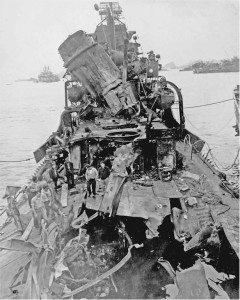
NARA. Via Stern (2010).
The effectiveness of a kamikaze hit was a matter of luck, but also of the nature of the target. The majority of ships sunk or damaged beyond repair by kamikaze attack were destroyers, and most of the remaining victims were landing ships. Not a single armored surface combatant (cruiser or battleship) was seriously endangered by a kamikaze strike. Fleet carrier Bunker Hill was very nearly sunk by kamikaze attack, and three escort carriers were lost to the kamikazes. British carriers, with their armored flight decks, provide highly resistant to kamikaze attack, though damage was not insignificant. Cargo ships
proved surprisingly resistant, with just seven cargo ships lost to
suicide attacks of all kinds. Most of these were carrying munitions.
The Allies were hard put to find an adequate
response to
this threat, and press reports on the kamikazes
were censored until 12 April 1945 to prevent the Japanese from knowing
how effective the attacks were. Task forces were reorganized to put a
heavier screen around larger groups of carriers. Radar picket destroyers
proved effective at protecting the core of the fleet, but at the cost
of
dangerously exposing the destroyers themselves. There were clear
indications of
declining morale among destroyermen
as a result. Each
picket destroyer embarked a fighter direction team (FIDO or "Freddies")
which coordinated local combat air patrol with a central amphibious command ship, such as Eldorado at Okinawa. Each picket destroyer was also accompanied by supporting warships, such as LCS or LSM, that came to be known as "pallbearers" because of their role in picking up survivors from sunken picket destroyers. The picket group would cruise in an area roughly 10,000 yards (9 km) across at
a speed of 15 knots, slow enough to avoid creating a prominent wake but
fast enough to quickly come to battle speed under attack. All contacts
were promptly reported to the command ship, but enemy aircraft were not
fired upon until they came within 12,000 yards (11 km). At that
distance, the antiaircraft gunners might have as little as a minute to
engage their target before impact.
A more promising
tactic was
to destroy the kamikazes before they could take to the air. Halsey threw a “Big Blue
Blanket” over the Philippines and Japan
with carrier strikes
on airfields that proved as effective as anything in
suppressing the
kamikaze threat. B-29s
were even briefly
diverted against kamikaze airfields,
over the loud protests of the Army
Air
Forces, who resented the use of their strategic bombers in a
tactical
role.
Proponents of the Allied blockade of
Japan argue that the blockade worked against the kamikazes by
eliminating the supply of aviation fuel. However, the postwar Strategic
Bombing Survey found that Japan still had a million barrels of aviation
fuel available at the time of the Japanese surrender. This was more than
adequate for the 5,350 kamikaze attacks planned in the event of an
Allied invasion of
Japan, and represented seven months' consumption at the July 1945 rate.
On the other hand, much of this fuel must have been of low quality,
such as that obtained by distillation of pine roots.
Adding to the difficulty of dealing with the kamikazes is that many were trainer aircraft which were small and hard to spot visually, with wood frames that made them hard to spot on radar as well. They were much less vulnerable to radar proximity shells than metal aircraft. When they made their approach at low altitude, picket destroyer radar often did not pick them up in time to give adequate warning. U.S. scientists responded by developing an airborne early warning radar system, CADILLAC, but this was still in the field testing stage at the time of the Japanese surrender. Meanwhile carrier task groups stationed "Jack Patrols" of fighters at an altitude of 3000 feet (900 meters) at each of the four cardinal points of the compass as protection from low-flying kamikazes, and returning American aircraft were required to circle around designated "Tom Cat" picket destroyers where any kamikazes attempting to follow them in could be detected and shot down.
Ships under attack were encouraged to maneuver radically
and to put the attacking aircraft on their beam, which unmasked their
antiaircraft battery and increased the chance of the kamikaze
overshooting or undershooting its target. However, U.S. Navy
operational researchers concluded that this was counterproductive for
low-altitude attack, and that the best course of action for a destroyer
under low-level kamikaze attack was to steer directly away from
the attacker and avoid radical maneuvers that degraded the accuracy of
antiaircraft gunnery. Naval officers in the combat zone asked for
increased delivery of proximity fused 5" antiaircraft shells, which
even in 1945 constituted only a third of 5" shells supplied to the
fleet.
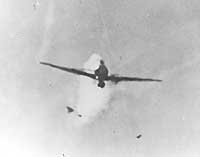
The concept of sacrificing oneself to destroy many enemies has its echoes in the terrorist movements that plague the world today. The kamikazes were a form of asymmetric warfare, aimed less at the enemy's military might than at the enemy's resolve to fight the war to a conclusion. By exacting a terrible price in blood, the Japanese hoped to compel the Allies to offer more lenient terms. Tragically, the actual consequence likely was to convince the average American that the Japanese, as a race, were mindless fanatics who would never surrender. This perception probably helped remove any remaining moral qualms about the fire bombing of cities and the use of nuclear weapons.
The tactics of the kamikazes are duplicated by modern antishipping missiles, which are essentially kamikaze aircraft with a computer chip in place of a human pilot.
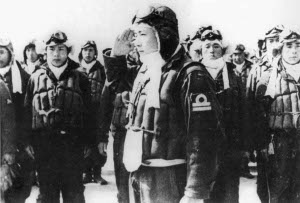
Naval History and Heritage Command #NH 73095
There was one maintenance man who made a point of meticulously scouring and polishing the cockpit of each kamikaze plane he tended. It was his theory that the cockpit was the pilot's coffin and as such it should be spotless. One recipient of this service was so pleasantly surprised that he summoned and thanked his benefactor, saying that the neatness of the plane meant a great deal to him. The maintenance man's eyes dimmed with tears, and, unable to speak. he ran along with one hand on the wing tip of the plane as it taxied for its final take-off.
(Inoguchi et al. 1958)
To the Americans, the kamikaze was a psychological
as well
as a physical threat. The idea of deliberately sacrificing one’s
life, with no
chance at all of survival, was difficult for the average American
sailor to
fathom. But in the Japanese military, death in the service of the
Emperor was
a privilege. Perhaps even more significant was the
concept of on (恩),
the unredeemable debt owed to one’s family, society and Emperor, that was
inculcated by Japanese wartime propaganda. This
is
not a concept
easily understood by Westerners, nor could it be articulated by many
Japanese. Japanese culture also was imbued with hoganbiiki,
"sympathy for the lieutenant", from the legend of Minamoto no
Yoshitsune, who was betrayed by his brother and forced to commit seppuku. Hoganbiiki is somewhat like the American concept of "rooting for the underdog", but in a darker form, extolling sincerity (makoto) even in a losing cause. That
the heroes of such legends not only failed, but accomplished nothing to
further their causes with their deaths, actually adds to their appeal
to the Japanese mind (Stern 2010).
Tsunoda Kazuo was an enlisted Army fighter pilot assigned to escort kamikazes during the Iwo Jima campaign (Collie and Marutani 2009):
I believe those who died by kamikaze attack didn't want to die, but they still took off with beaming smiles. Those young boys [they were mostly teenagers] looked so anguished on the evening before they left. But when they gathered on the airfield the next morning, they were all smiling as if they'd changed into someone else. I cannot explain what was in their minds.
Letters from kamikaze pilots very often spoke of on,
expressing a hope that their deaths would in some small way repay the
debt they owed to their families and country. Very few mentioned any religious
motivation for their sacrifice. Nor did many pilots express a belief
that their deaths would change the course of the war; much more common
was the hope that their sacrifice would renew the spirit of the nation (Yamato-damaishii)
and so give the nation the moral strength to survive defeat. In other
words, they accepted that Japan would lose the war, but put great
importance on how Japan lost the war.
Nevertheless, it is a myth that the kamikazes were all volunteers. During their initial campaign, in the Philippines, the kamikazes were exclusively volunteers drawn from regular air units, but there are hints that the proposal to carry out kamikaze attacks provoked strong opposition. Onishi told his staff that (Inoguchi et al. 1958):
We will tolerate no criticism of any kind of the operations that are about to be undertaken. We know that younger men do not complain or gripe, but old-timers are frequently given to criticizing the decisions of their superiors. Stern discipline will be meted out to anyone who criticizes orders or neglects to carry then out. In flagrant cases there will be no hesitancy about exacting the extreme penalty.
By the time of the great kamikaze campaign off Okinawa, the majority of the kamikazes had been conscripted for such duty. Many were university students or others previously exempt from military duty. This is reflected in the hit statistics: During the Philippines campaign, some 26.8% of kamikazes hit a ship and 2.9% sank their target, which was almost double their effectiveness during the Okinawa campaign. However, the numbers at Okinawa were much greater. That these inexperienced pilots retained as much effectiveness as they did at Okinawa reflects the improvements in kamikaze tactics.
Immediately following the Philippines campaign, the heavy
expenditure of trained pilots meant that Onishi could be assigned as
replacements only 150 reserve ensign pilots who could barely land or
take off. Onishi's staff set up a crash course for inexperienced pilots
at the Taichu and Tainan air bases on Formosa.
The first four days were devoted to teaching basic formation flying,
while the final three days were devoted to approach and attack tactics. Mass coordinated attacks were
emphasized, as was approaching the target at high or low altitude to
avoid Allied CAP, which were typically deployed at medium altitude.
Flights of these inexperienced pilots were led by an experienced flight
leader, and Allied observers likened them to
... a flock of pelicans — each bird following the leader in a loose ragged file and flying very close to the water. Only one individualist broke away to approach independently ... the impression gained was that the leader of each formation was an experienced aviator, but that all of the others had had barely enough flight time to solo.
(Stern 2010). The use of experienced pilots as flight leaders for kamikaze
attacks further depleted the shrinking pool of experienced pilots, who
were increasingly drawn from training formation where they had been
passing along their skills to novice pilots.
It is also a myth that the fanaticism of the kamikazes was unshakable. When the Allied campaign in the Philippines moved so rapidly that a planned deployment of an Ohka unit had to be canceled, "many pilots began to question their resolve" (Sears 2008). Discipline nearly broke down on 9 January 1945 following a drunken confrontation between older non-commissioned pilots and young reserve commissioned pilots, and two of the non-commissioned pilots were tried by court-martial in order to restore discipline. By May 1945 the Ohka pilots operated "under a cloud of despondency" and did not even bother to seek shelter during air raid alerts. Nakajima Tadashi, a staff officer of 5 Air Fleet during the Okinawa campaign, later admitted that (Inoguchi et al. 1958):
Many of the new arrivals seemed at first not only to lack enthusiasm, but, indeed to be disturbed by their situation. With some this condition lasted only a few hours, with others for several days. It was a period of melancholy that passed with time and eventually gave way to a spiritual awakening. Then, like an attainment of wisdom, care vanished and tranquility of spirit appeared as life came to terms with death, mortality with immortality.
What Nakajima described as "a spiritual awakening" might cynically be described by a Westerner as fatalistic resignation.
The failure of many missions also eroded morale. Yamamura Keisuke, an Ohka pilot, had his first two missions abort before he could launch. While waiting to embark for his third attempt, he burst out "Hurry up! Kill me! Get if over with!" and later recalled that he "was beside himself with fear. It was all he could do to keep from screaming that he just couldn't go through with it." When the time came for launch, the launch mechanism for his Ohka failed. "Screaming in hysteria and desperate to shake it loose, Yamamura rocked the craft side to side. ... In the end it was no use, and there was only one place Yamamura could go— out of his coffin and back into the cabin of the Betty for the return flight." It was the last operational sortie for the Ohka.
Had the war continued, the Japanese might have completed development of the Baika, which was essentially a German V-1 pulse jet with a human pilot. The attitude of the developers was (quoted by Grunden 2005):
The V-1 lacked eyes. In view of the lessons learned from our study of the robot bomb of our friendly Ally (Germany), we must give the V-1 eyes. However, not every country can manufacture the eyes for this destructive weapon.
This reveals both the idealistic view that the kamikazes represented the unique Yamato spirit and the pragmatic view that pilots were expendable missile guidance systems.
Terrifying as the kamikaze campaign was, the statistics suggest it was not likely to be decisive. Some 4000 Japanese died in kamikaze attacks, killing nearly 5000 Allied fighting men and wounding another 4800. About 125 kamikaze aircrew were expended for each warship sunk. While this ratio favored the Japanese, the margin was inadequate against the Allied material advantages.
The use of kamikaze tactics seems to have shocked the Japanese people themselves, though they were in no position to speak openly against it during the war. When informed of the first kamikaze attacks, the Emperor is reported to have said "Was it necessary to go to this extreme? They certainly did a magnificent job" (Inoguchi et al. 1958), which Onishi interpreted as a veiled rebuke. Postwar criticism was much less restrained, with Prime Minister Suzuki Kantaro later writing that "An able commander would never resort to such extreme measures" (Inoguchi et al. 1958). Dr. Suzuki Daisetsu (no relation), an authority on Zen Buddhism, wrote an article for Sekai in March 1946 in which he accused the military of cynically holding back their professional pilots in favor of sacrificing poorly-trained college students.
Not all suicide tactics involved aircraft. In preparation for the
anticipated Allied invasion,
the Japanese Navy began training about 4000 fukuryu or "crouching dragon"
units. These were divers, many in their mid-teens,
from whom firstborn sons, the fatherless, and the those who were above
average in intelligence had been screened out. They who were expected to
destroy Allied landing craft
with pole charges. The concept was completely out of touch with
reality. There was little chance that the fukuryu would survived the
underwater shock waves from the bombs
and shells of the Allied pre-landing bombardment, even if the Japanese
had been able to complete the concrete
and steel shelters being
planned. Nor was it at all likely they would be able to attack a
fast-moving landing craft with a clumsy weapon. Furthermore,
the fukuryu were taught to
operate in teams, but the first to explode his charge would kill the
others in his team along with himself.
The breathing apparatus with which the fukuryu were equipped
was a simple caustic lye rebreather, lacking proper valves, so that
trainees had to remember to exhale through their mouths and inhale
through their nostrils or risk inhaling caustic lye. One survivor of the
program recalled that over half his group of trainees perishing in
training accidents (Branfill-Cook 2014). The pole charges supplied to the fukuryu
were approximately 11'(3.34m) long and were tipped with a small mine
(Attack Mine Type 5) with a small explosive charge and a buoyancy
chamber,
The Japanese Navy also began experimenting with manned torpedoes. Unlike the Italian manned torpedoes that had proven effective at Alexandria harbor early in the European war, the Japanese version had no provision for the crew to escape. The manned torpedoes claimed some merchant vessels at Ulithi Atoll, and it has been suggested that they were responsible for the destruction of Mount Hood and Indianapolis. The Japanese Navy also developed suicide motor boats, after experiments with motor boats carrying depth charges, whose crews had at least a theoretical possibility of survival, proved ineffective.
The concept of suicide as part of an attack pattern had a long history in the Japanese submarine service. Though Japanese midget submarines were equipped with torpedoes, so that they could stay clear of their target and theoretically had some possibility of returning from an attack, their crews seem to have dismissed the possibility of survival from the start. After visiting the midget submarine crews preparing for the attack on Pearl Harbor, Ugaki noted in his diary that "The firm determination not to return alive on the part of those young lieutenants and ensigns who smilingly embarked on their ships cannot be praised too much. The spirit of kesshitai [self-sacrifice] has not changed at all" (Prange 1981).
The Japanese forces at Meiktila, and probably elsewhere, adopted a desperate antitank defense consisting of soldiers in spider holes with aircraft bombs and bricks. If a tank drove over a soldier's position, he was expected to hit the fuse of the bomb with the brick and blow up himself and the tank (Allen 1984):
They had been over this ground the day before, and [Colonel Alan Wakefield] now noticed that it was covered in pock marks in regular lines. He told the tanks to stop and cover him with their guns, then went forward and began to shoot each human mine in the head. Every now and then he would pause to reload, then move on to the next series of pock marks. None of the Japanese detonated their bombs— Wakefield was not a tank, and they had been told to do it only for tanks — and he remained miraculously unscathed by fire from the Japanese in the railway station ... The ground was clear, and the tanks rolled on.
References
Collie and Marutani (2009)
Frank (1999)
Gordon (2012-2-1; accessed 2012-2-19)
Inoguchi, Nakajima, and Pineau (1958)
Prange
(1981)
Ryang
(2002; accessed 2009-5-10)
The Pacific War Online Encyclopedia © 2007-2015 by Kent G. Budge. Index